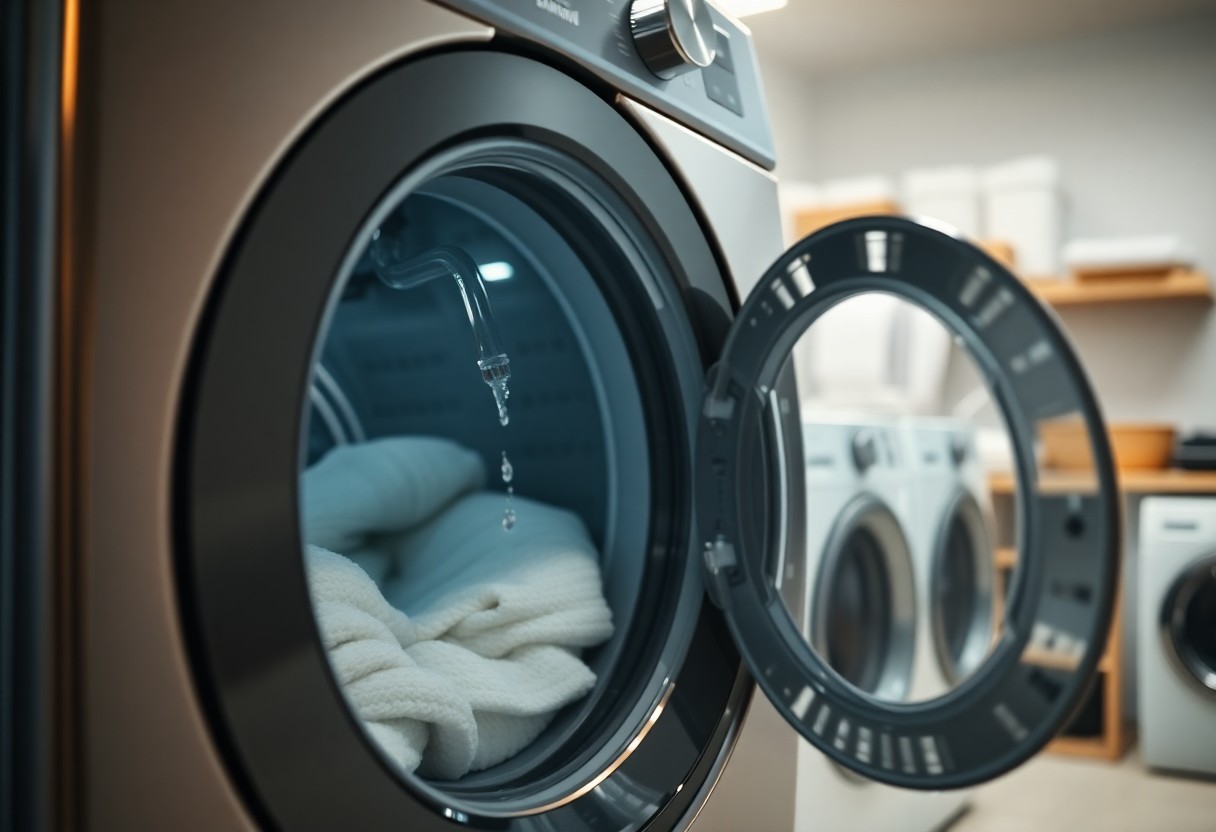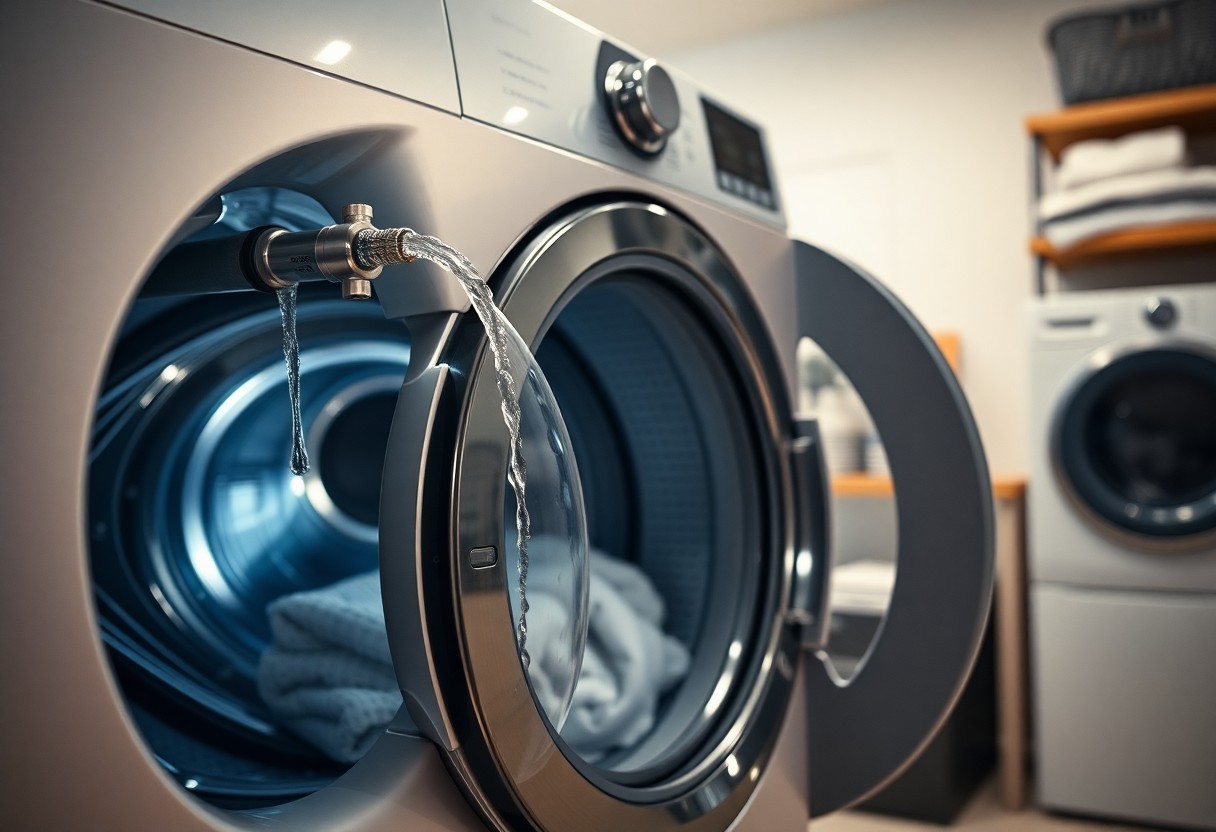Over time, you might have noticed the significant role that cold water plays in your Samsung dryer’s performance. This crucial component is not just about water temperature; it also impacts energy efficiency and can help prevent potential damages to your appliance. By understanding how your dryer utilizes cold water, you can ensure it runs smoothly while maximizing its lifespan. In this post, we’ll simplify the science behind your appliance’s operation and why you should pay attention to its water settings.
Key Takeaways:
- Using cold water in your Samsung dryer helps prevent damage to sensitive fabrics and reduces the risk of shrinking or fading clothes.
- Cold water aids in efficient filtering and removal of lint and debris, ensuring optimal dryer performance and longevity.
- Introducing cold water helps in balancing the dryer’s internal temperature, which can lead to energy savings and improved overall drying efficiency.
The Role of Cold Water in Drying
Your Samsung dryer relies on cold water to efficiently manage the drying process. By cooling down the drum, the dryer creates an environment that allows moisture to be effectively evaporated from your clothes. This process is vital for achieving optimal drying results, helping to reduce wrinkles and maintain the integrity of your fabrics while ensuring your drying cycle runs smoothly.
Understanding Moisture Removal
To effectively remove moisture from your laundry, your dryer needs to create a balance between heat and cooling. Cold water helps in condensing steam back into liquid, which is then extracted from your clothes. This controlled moisture removal prevents over-drying and protects your garments from damage while promoting faster drying times.
Impact on Energy Efficiency
At the heart of energy efficiency lies the relationship between cold water and drying performance. Utilizing cold water in your Samsung dryer means less reliance on high heat settings, which can consume a significant amount of energy. By keeping the drying process cooler, you not only save on your utility bills but also extend the lifespan of your dryer and your clothes.
The impact of cold water on energy efficiency cannot be overlooked. By integrating cold water into your drying cycle, you’re actively contributing to lower energy consumption, which can lead to substantial savings on your utility bills. Additionally, by avoiding excessive heat, you minimize the risk of wear and tear on both your dryer and your garments, ensuring they last longer and continue to look their best. This simple adjustment in your drying routine can lead to a significant positive change in both your budget and appliance longevity.
Cold Water vs. Hot Water: A Comparative Analysis
Assuming you are considering the best option for your Samsung dryer, it’s vital to evaluate the differences between cold and hot water. Below is a comparative analysis, which reveals their distinct characteristics:
| Factor | Cold Water |
|---|---|
| Energy Consumption | Lower |
| Fabric Care | Gentler |
| Stain Removal | Less Effective |
| Drying Efficiency | Optimal |
Benefits of Using Cold Water
Below are some advantages of using cold water in your dryer. Cold water helps save energy costs, reducing your utility bills. It is also gentler on fabrics, extending the lifespan of your clothes and maintaining their color vibrancy. Furthermore, using cold water minimizes the risk of shrinkage, maintaining the correct fit of your garments over time.
Downsides of Hot Water Usage
With hot water, you may encounter several drawbacks that impact your laundry process. High temperatures can lead to excessive wear and tear on your clothes, not to mention increased energy costs. Hot water can also cause certain fabrics to shrink or lose their shape, impacting the overall fit and appearance of your wardrobe.
Water at elevated temperatures can harm your fabrics in various ways. It can weaken fibers, leading to fading and eventually resulting in clothing that looks worn out much quicker than it should. Additionally, using hot water often increases your energy usage, causing your bills to spike. The combination of these factors highlights the importance of considering cold water as a more sustainable and fabric-friendly option for your laundry needs.

Maintenance of Samsung Dryers
After investing in a Samsung dryer, regular maintenance is vital to ensure its longevity and optimal performance. This involves simple tasks that you can easily incorporate into your routine, including cleaning the lint trap and checking the venting system. Proper maintenance not only enhances the efficiency of your dryer but also minimizes the risk of discrepancies that can lead to costly repairs.
Importance of Regular Cleaning
Along with ensuring efficient drying cycles, regular cleaning prevents lint buildup, which can pose a fire hazard in your home. By keeping your dryer clean, you help maintain its performance and reduce energy consumption, ultimately saving you money on your utility bills. It’s an easy yet effective way to extend the lifespan of your appliance.
Avoiding Common Problems
Above all, being proactive about maintenance can help you sidestep common dryer issues, such as overheating or reduced drying efficiency. Regularly cleaning vents, inspecting hoses, and checking for blockages will enhance your dryer’s performance and ensure safety.
Another significant way to avoid issues is to pay attention to signs of wear and tear. If you notice unusual noises or decreased drying performance, it’s vital to inspect your dryer promptly. Ignoring these red flags could lead to more serious problems down the line. Furthermore, regularly clearing your lint trap and keeping the venting system unobstructed can greatly reduce the risk of fires. Ensuring that the dryer is adequately ventilated helps maintain optimal energy efficiency, ensuring that your appliance operates safely over its lifespan.
Troubleshooting Cold Water Issues
For any inconvenience with your Samsung dryer, cold water issues can often be the culprit. If your dryer isn’t heating or performing adequately, it’s important to address potential problems with the cold water supply. Checking the water source, hoses, and connections can help you identify the root cause of the issue. Maintenance and troubleshooting will ensure your dryer continues working efficiently.
Diagnosing Cold Water Problems
Water supply issues can lead to improper dryer functionality and affect your laundry’s cleanliness. You should start by checking if the cold water valve is fully open and ensuring there are no kinks in the hoses. If you notice the water pressure is low or inconsistent, this could be a sign of a problem with your plumbing, which warrants further investigation.
Solutions and Fixes
One effective way to address cold water issues is to inspect your hoses for any blockages or leaks. Ensure that all connections are tight and free from damage. Additionally, consider checking your home’s water pressure. If it’s too low, you may need to contact your local plumbing service for assistance.
And if you’ve identified a blockage, you may need to clear it by detaching the hoses and running water through them to flush out any debris. Make sure the water valve is open fully and check for leaks when you’ve reattached the hoses. If low water pressure persists, it could be a significant plumbing issue, and you should seek help from a qualified professional to avoid potential flooding or water damage.
Best Practices for Optimal Dryer Performance
All Samsung dryers work best when you follow a few simple practices. Regularly clean the lint filter before each load, as a clear filter improves airflow and drying efficiency. Additionally, keep the dryer vent and ductwork free from obstructions to enhance performance. Periodically inspect the hose for any signs of wear or damage to ensure that your dryer operates safely and effectively.
Recommended Drying Techniques
Beside following your dryer’s specific instructions, try grouping similar fabric types together to ensure even drying. Thicker items, like towels, often take longer, so drying heavier loads separately can prevent under-drying lighter fabrics. Using dryer balls can also help separate garments, allowing the hot air to circulate better.
Settings and Adjustments
On your Samsung dryer, selecting the right settings can make a significant difference in your laundry results. Pair the drying cycle with the fabric type and the moisture level of the load for optimal performance.
In addition, exploring the various settings on your dryer can dramatically improve drying outcomes. For instance, using high heat for heavy fabrics, such as blankets, can effectively remove moisture, while low heat is advisable for delicate items to avoid damage. Always consult the user manual for your specific model to ensure you are leveraging all available features, such as sensor dry and quick dry options, which enhance safety and energy efficiency by preventing your clothes from overdrying.

User Experiences and Testimonials
Unlike traditional dryers, many Samsung dryer users have noted the positive impact of using cold water in their laundry routines. They mention better drying efficiency and reduced static cling, leading to a more pleasant experience. With improved fabric care and energy savings, your laundry days could be transformed, making your Samsung dryer a favorite household appliance.
Customer Feedback
On numerous online forums, customers rave about their satisfaction with Samsung dryers, particularly highlighting how cold water settings have improved their laundry results. Users often share stories of softer fabrics and reduced wrinkles, helping to elevate your everyday laundry experience.
Expert Opinions
Behind the scenes, appliance professionals emphasize the role of cold water in enhancing Samsung drying technology. They argue that using cold water minimizes wear on fabrics and supports better moisture retention during the drying process.
A growing number of experts advise that using cold water with your Samsung dryer can lead to improved energy efficiency and less strain on your clothes. Professionals caution that hot water can cause shrinkage and color fading, while cold water helps maintain your garments’ original condition. Furthermore, this method aligns with modern sustainable practices, significantly reducing your household’s environmental footprint.
Conclusion
Ultimately, understanding why your Samsung dryer requires cold water is vital to ensuring its optimal performance and efficiency. The cold water helps maintain the right temperature for the drying cycle, prevents overheating, and protects the internal components of your machine. By incorporating cold water into your dryer’s operation, you can enhance its longevity and improve drying results, making your laundry experience smoother and more effective. Keep these insights in mind to boost your dryer’s performance and safeguard your investment.
FAQ
Q: Why does my Samsung dryer require cold water?
A: Cold water is vital for specific dryer functions, especially for the drying process. Many Samsung dryers feature moisture sensing technology that uses cold water to help manage humidity levels inside the dryer. This allows the dryer to operate more effectively, optimizing drying times and improving energy efficiency.
Q: What happens if I don’t connect cold water to my dryer?
A: If cold water is not connected, the dryer may not function properly. It can lead to longer drying times and inefficient energy use since the moisture sensors will not be able to detect the actual moisture level in the clothes, potentially causing damage to fabrics from overheating or over-drying.
Q: Is cold water supply the same as the washing machine supply?
A: While both may originate from the same plumbing, the cold water supply to the dryer is usually separate from that of the washing machine. You will have to ensure that the dryer is correctly connected to its own cold water line for optimal performance.
Q: Do all Samsung dryers require cold water?
A: Not all Samsung dryers require a cold water connection, but many modern models do. It is important to consult the user manual for your specific model to determine whether a cold water connection is necessary and what functions depend on it.
Q: Can I use hot water instead of cold water for my dryer?
A: Using hot water in place of cold water is not recommended. The dryer is specifically designed to operate with a cold water supply for its moisture sensing capabilities and temperature control. Using hot water could disrupt the dryer’s functionality and lead to unwanted issues.
